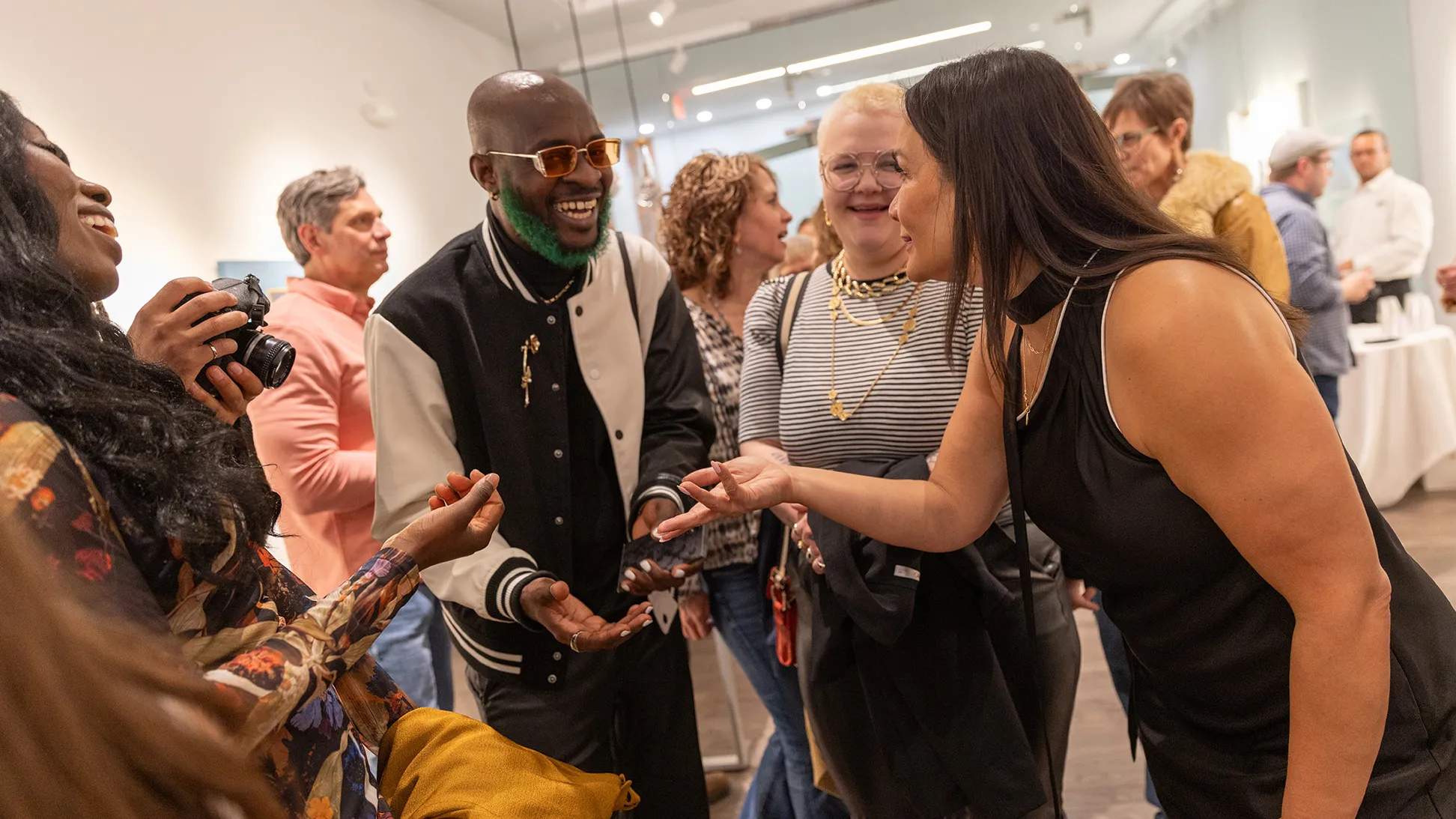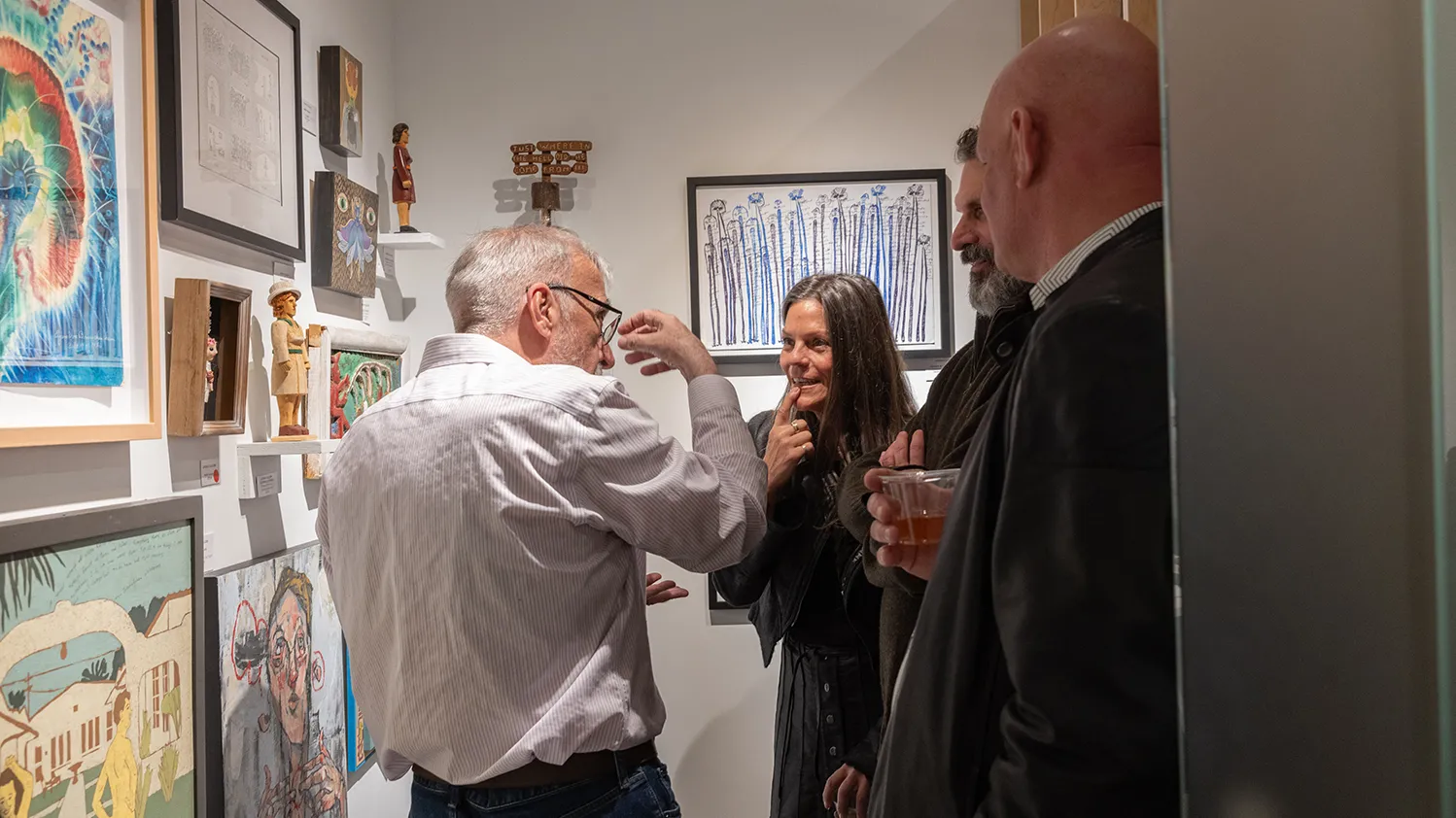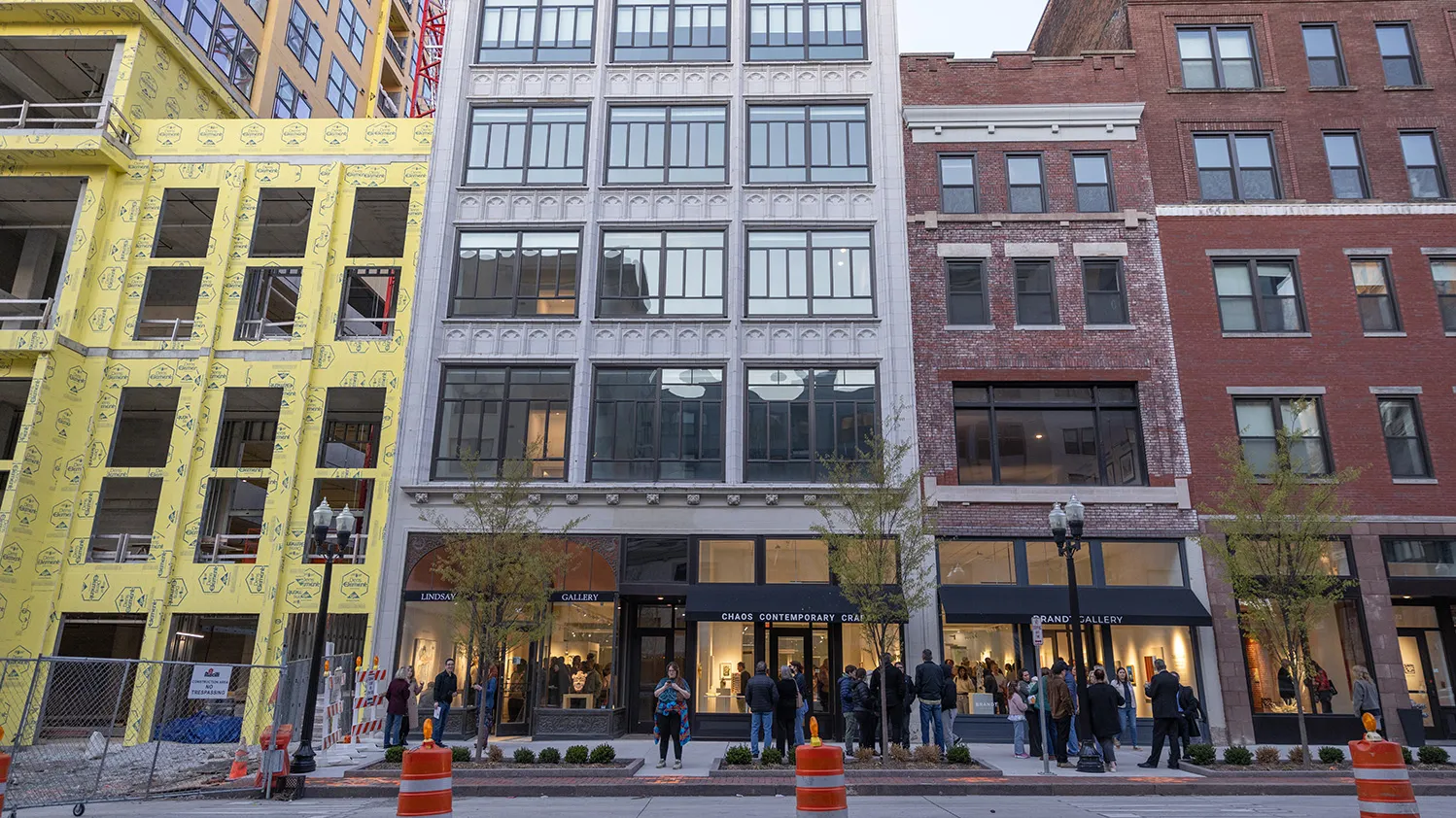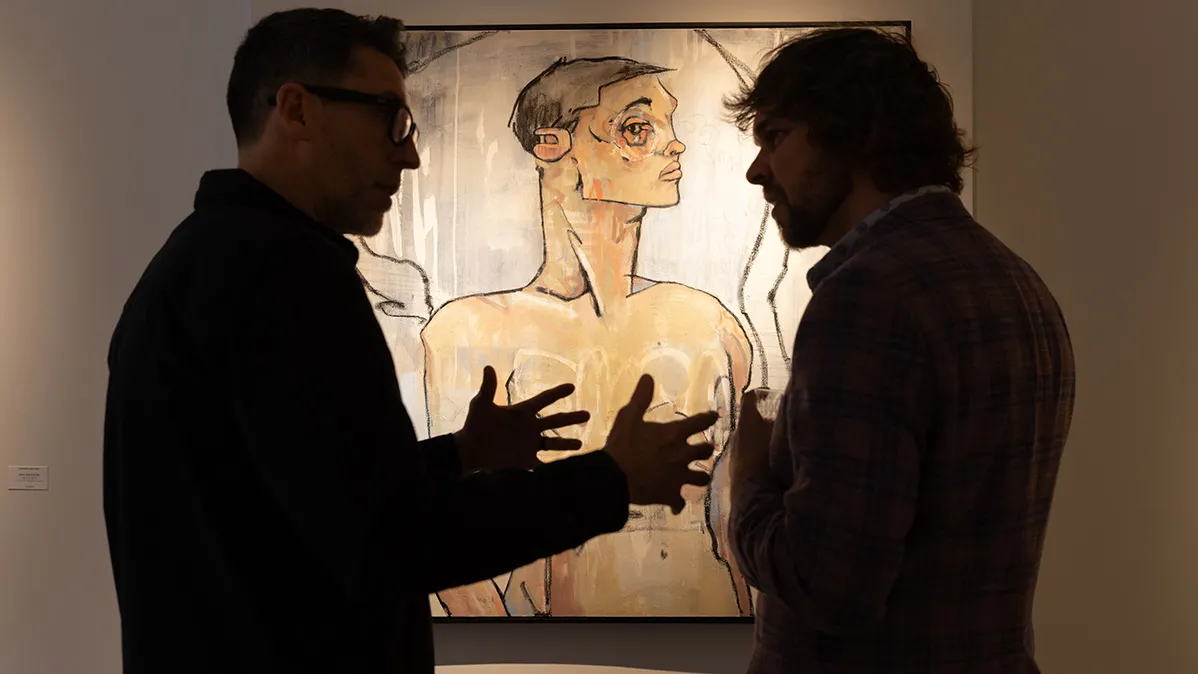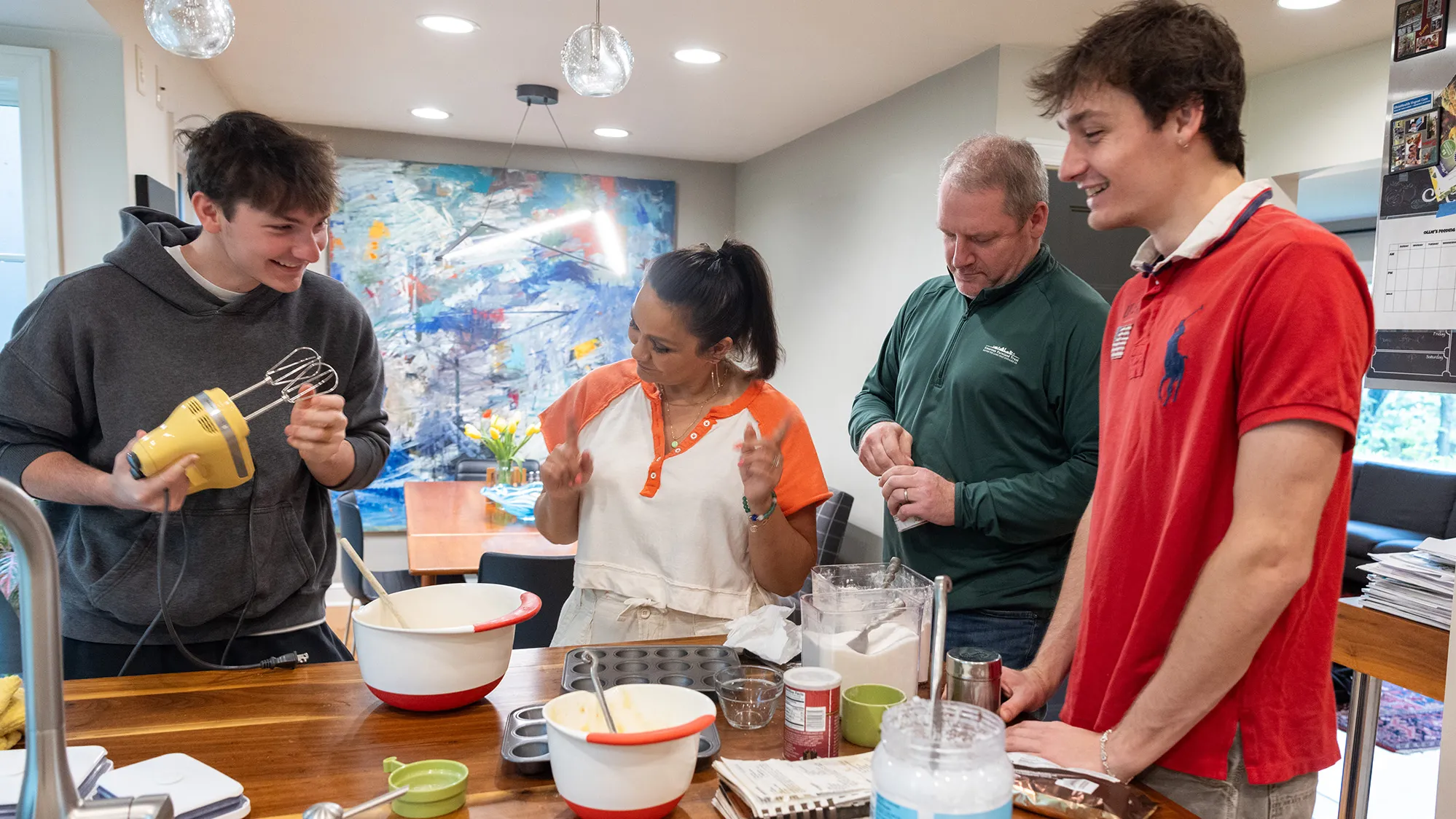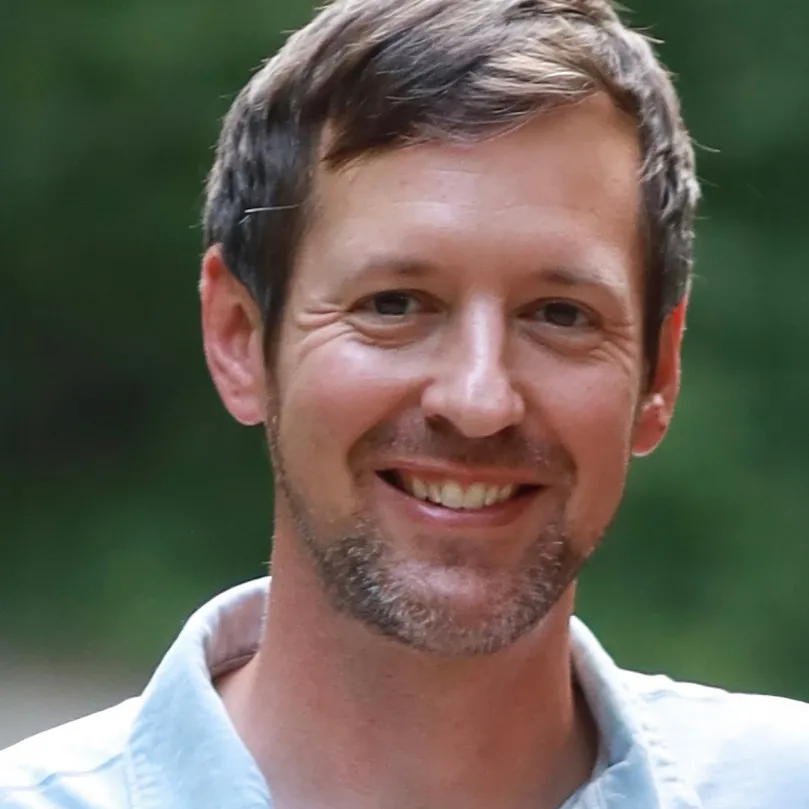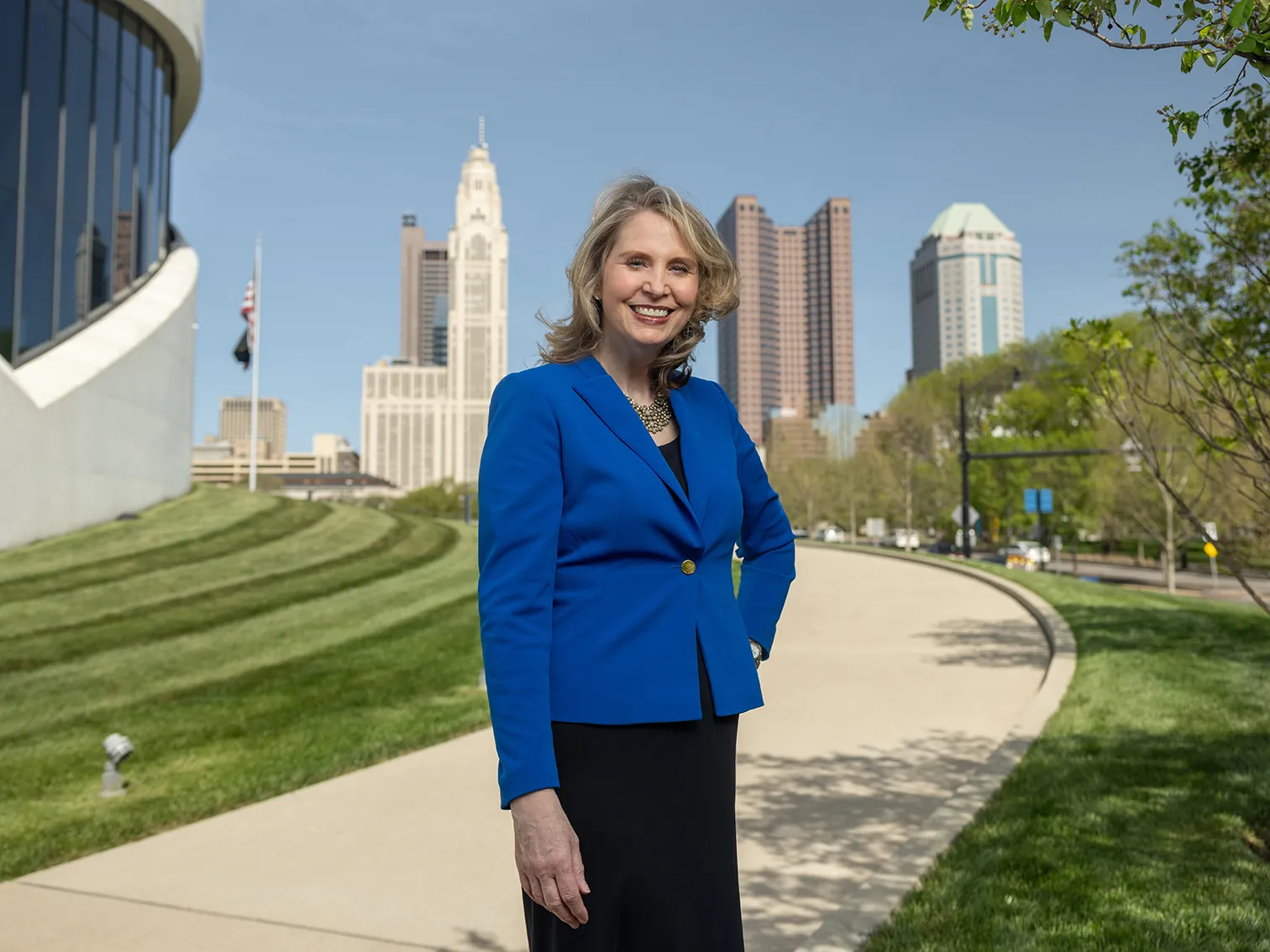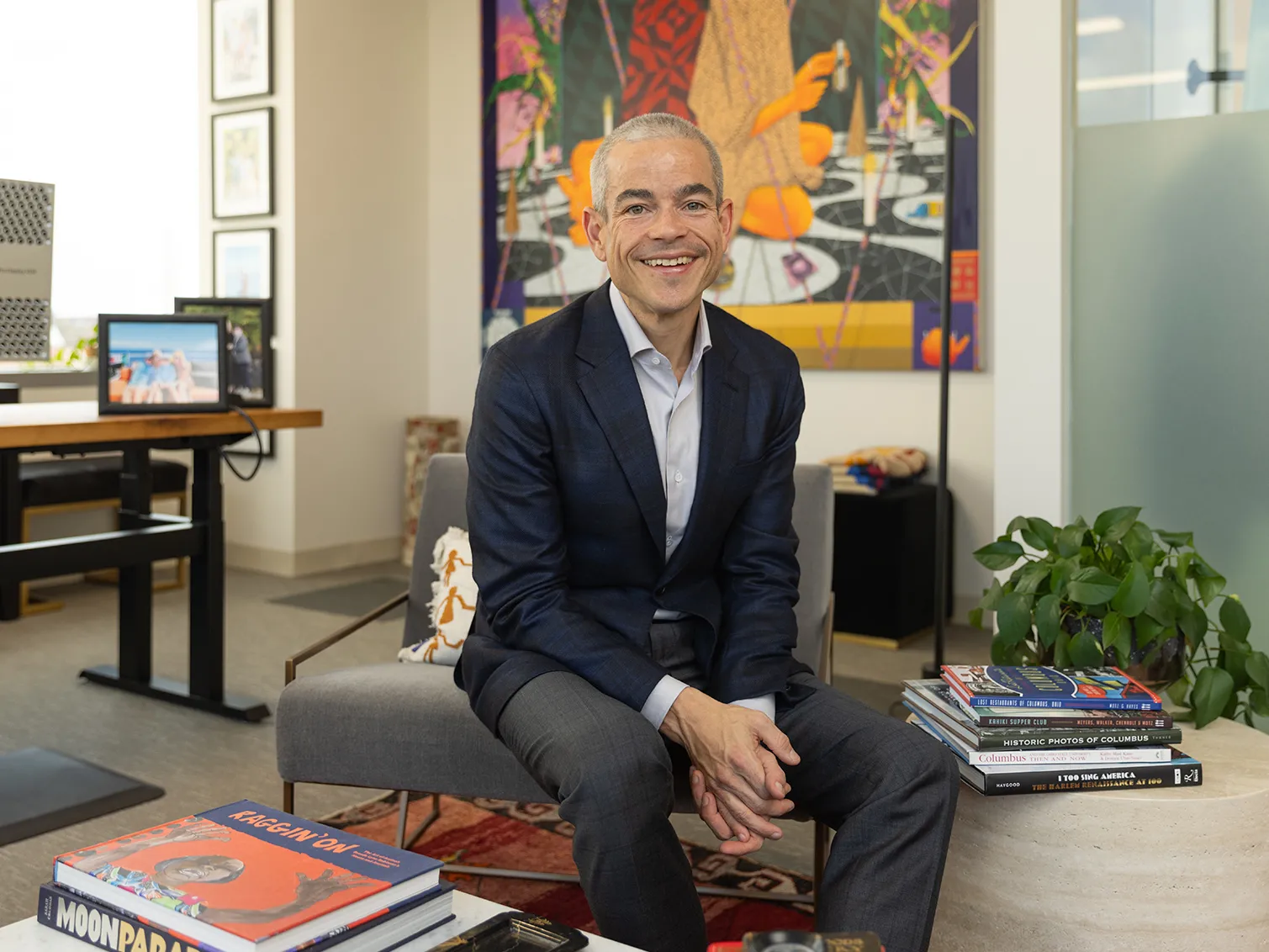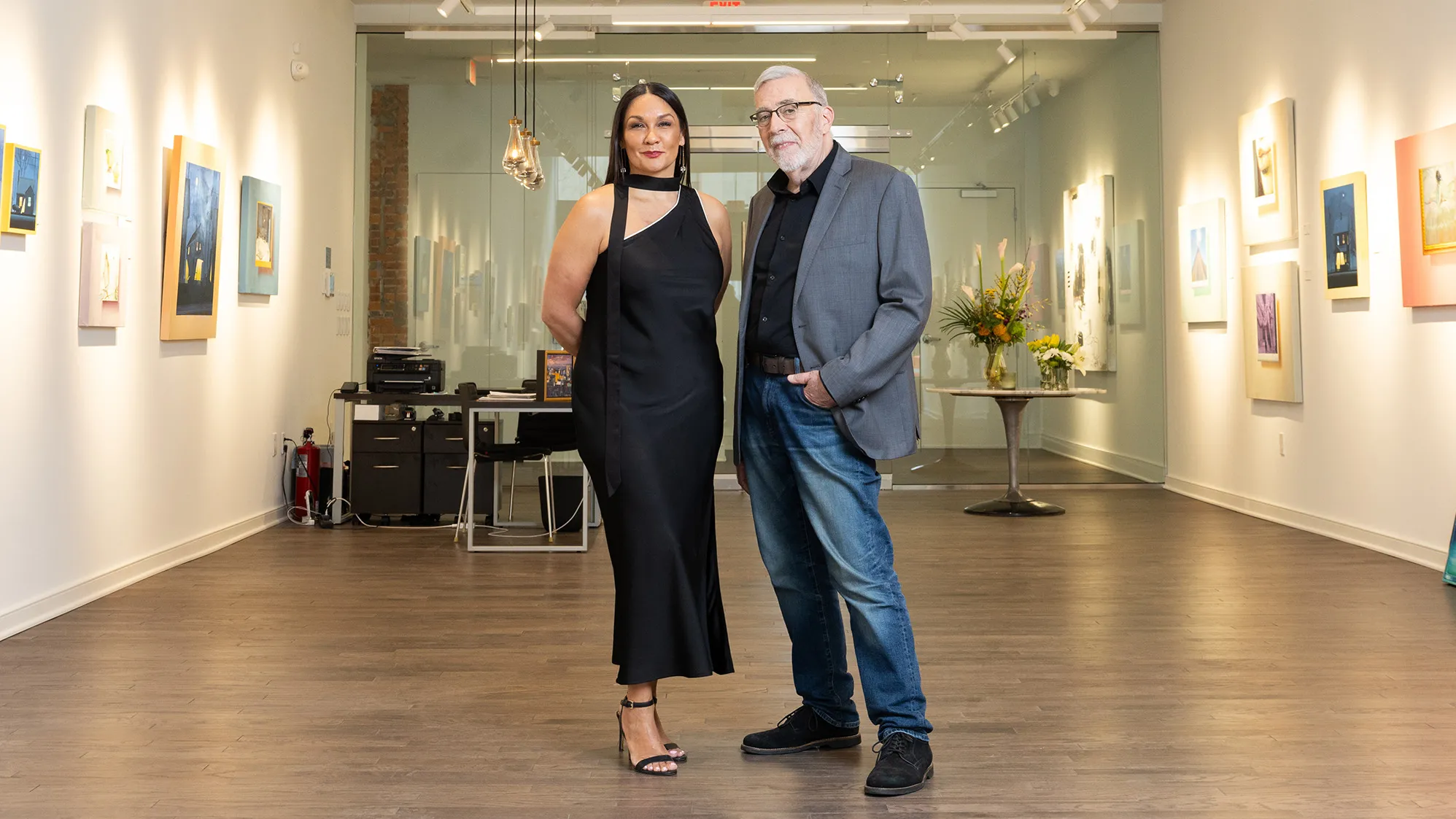
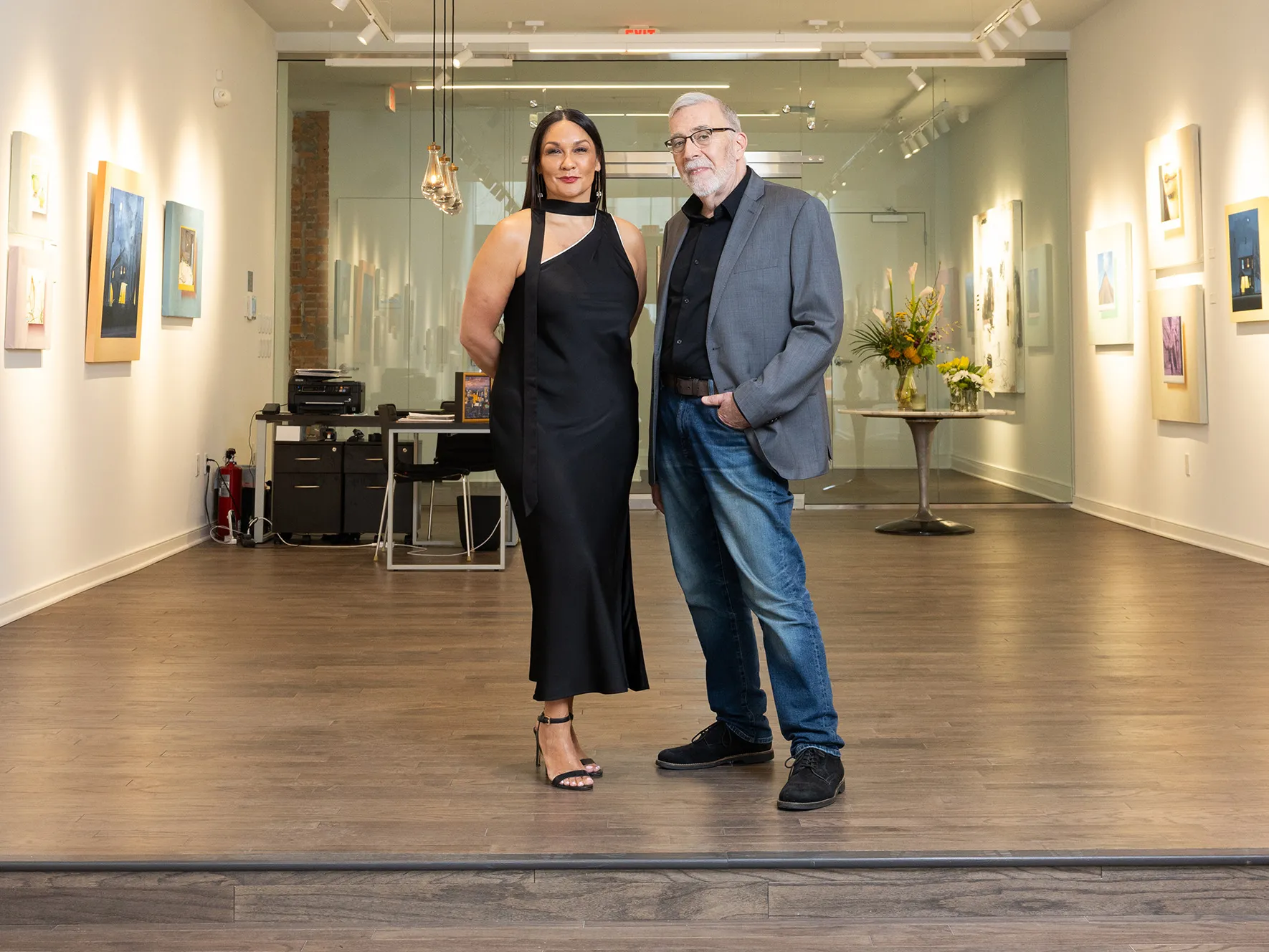
Art allies
With grit, foresight and resilience, Columbus gallerists Michelle Brandt ’96 and Duff Lindsay ’74 overcame life-threatening crises, rebooted their businesses and are pioneering a revitalized downtown corridor.
The urban transformation is on full display. Foodies and art lovers crowd Gay and High streets, a once-ignored corner of downtown Columbus. They scuttle in and out of swanky new restaurants. They walk under a monumental, multicolored fiber sculpture that hangs above the intersection. And they visit a pair of familiar local names that have brought artistic credibility to this rejuvenated area.
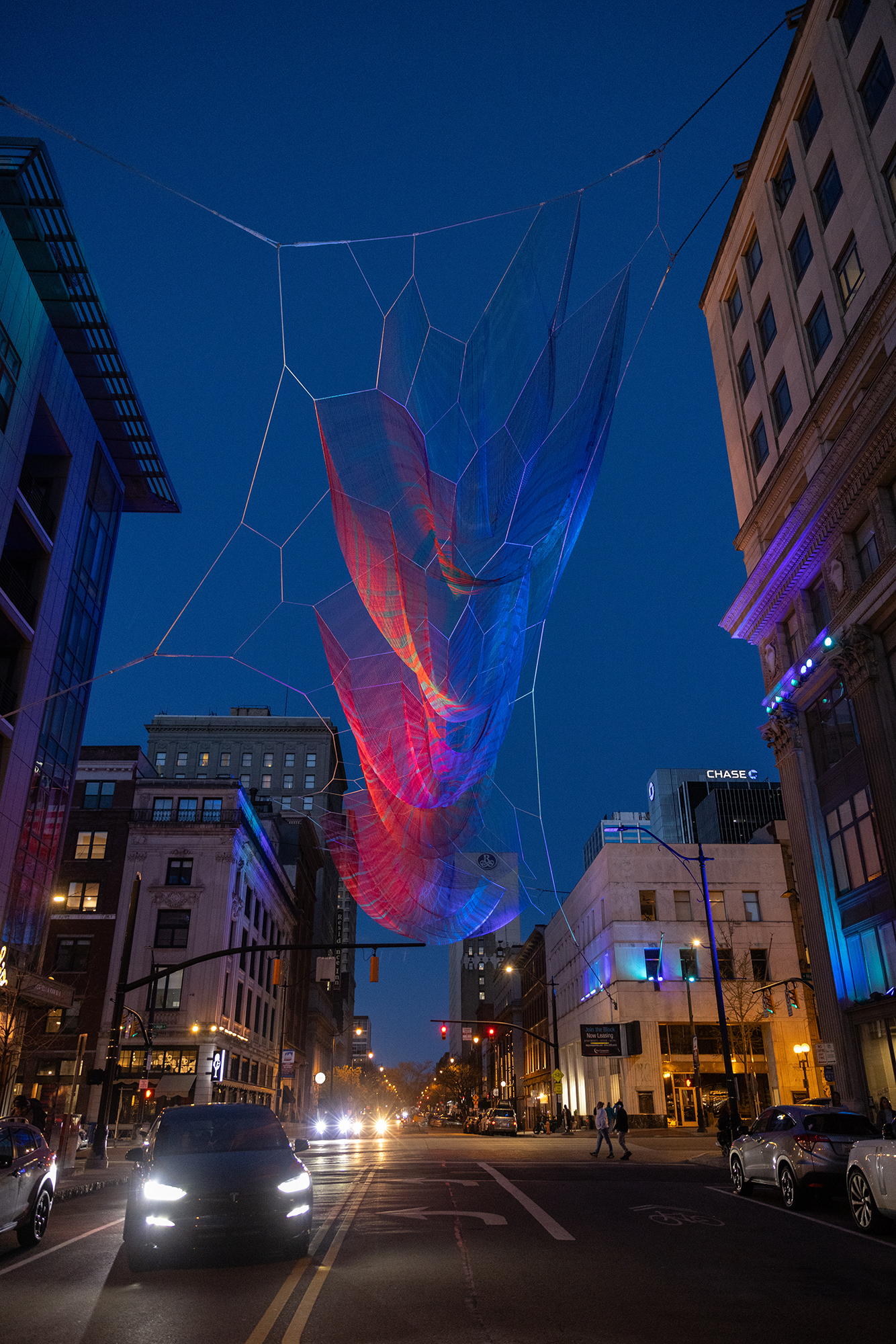
Pillars of the Columbus visual arts scene, Michelle Brandt ’96 and Duff Lindsay ’74 have relocated their businesses, Brandt Gallery and Lindsay Gallery, to downtown Columbus. On a brisk Saturday night in mid-April, they host grand openings for their new spaces, joined by a third gallery, Chaos Contemporary Craft, also debuting. All three are in the historic, long-neglected Madison’s Department Store and White Haines buildings, two neighboring, gorgeously renovated structures. While a DJ provides a clubby soundtrack, supporters pack the spaces, sipping wine, noshing on charcuterie, admiring art and celebrating the architectural restorations. Scanning the crowd, someone always seems to be mouthing the word, “Wow.”
The journey to this celebratory evening was full of twists and turns for Brandt and Lindsay, two friends who are opposites in many ways. Lindsay, 73, specializes in outsider art and is nationally known for his expertise. He’s genial, approachable and blunt about what he likes and dislikes. Brandt, 52, is a diplomatic, savvy entrepreneur with a sharp eye and an elegant presence. Her gallery focuses on contemporary works in a variety of styles with an emphasis on social narratives.
When life threw them curveballs, they both learned to depend on their community of artists—and on each other. “Michelle is a fighter, man, and I’m glad she’s in my corner,” Lindsay says.
“I’ve been there for him,” Brandt says, “and he’s been there for me.”
Michelle Brandt can’t remember a time when art wasn’t a part of her life, though she didn’t have many opportunities to follow that interest while growing up in the western Ohio village of St. Henry. “I was an art kid, and while I had lots of friends, I didn’t always feel like I fit in,” Brandt says. “Some of that was cultural—my mother was a Mexican immigrant, and she was very creative.”
When she came to Ohio State in 1991 to study art education, Brandt’s world began to expand. Thanks to a Wexner Center for the Arts event, she fondly remembers meeting legendary pop artist Roy Lichtenstein ’46, ’49 MA, ’88 HON, who died in 1997. “The Wexner Center gave me a glimpse into what was happening internationally—a window into the rest of the art world,” she says.
Those years were difficult, too. During her time at Ohio State, Brandt’s father died of a heart attack at 49. The loss sent her reeling, and she stopped going to classes. About a month later, one of Brandt’s professors called and encouraged her to come back. The pep talk worked. She completed her teaching certificate and took a job teaching art in a low-income middle school in Charleston, South Carolina.
Leaving Columbus helped Brandt deal with her grief, but it was also a shock to the system. “I had just come out of the best art education school in the country, and when I got to Charleston, I think my budget for supplies that first year was $75,” she says. Brandt gave it her all and eventually earned a Teacher of the Year award. She also made friends with someone who worked at a gallery. “I would go see her on Saturdays, and she told me about a gallery down the street that was hiring,” she says. “I had no gallery experience, but he hired me on the spot.”
That gallery introduction planted a seed. Brandt gave birth to her first son in Charleston, then returned to Columbus in 2002 and had her second son. While taking care of her boys, she worked part time in galleries. In 2010, she and a business partner opened Brandt-Roberts Galleries on High Street in the Short North Arts District, half a mile south of Lindsay Gallery and her soon-to-be friend, Lindsay.
Brandt developed a head-turning roster of emerging artists (Aaron Troyer ’06, Akeylah Imani Wellington ’23 MFA) and established (Christopher Burk, Terry Rodgers) artists. “She really cares about her artists,” says painter Richard Lillash, who is represented by Brandt and works for her as a gallery associate. “She also has an understanding that it’s a business and you have to figure out ways to sell art. She’s good at finding different avenues where she can promote her artists. You can’t just sit in the gallery and wait for clients to walk through the door.”
Over time, Brandt-Roberts became one of the most respected galleries in Columbus. Then, in 2018, Brandt’s world was turned upside down with a Stage 4 colon cancer diagnosis. “The cancer spread everywhere,” she says. “My kids were in middle school, and I’m looking at them, saying, ‘The odds are not good.’ I was trying to keep the gallery open, but even more so, I just wanted to see my kids grow up.”
After the initial surgery, before she could even walk to the end of her driveway, Brandt began six months of aggressive chemotherapy. “The chemo bag connected to me through a port, and for 48 hours it would pump poison in me. I could taste it,” she says. “I thought, how am I ever going to survive this?”
Brandt credits her survival in part to her former oncologist at The James Cancer Hospital, Dr. Jeffrey VanDeusen ’04 PhD, ’06 MD, not merely for his care, but for his art therapy referral. “He said, ‘This is going to be a mental battle as much as a physical battle,’” says Brandt, who worked with Ohio State art therapist Anne Harding ’76. “Those art therapy sessions were life changing. I realized that art could be healing.”
Brandt kept her illness private for a while, but eventually she began speaking about it. Lindsay was one of the first colleagues she told. Brandt says the overwhelming support and encouragement from the community of artists and gallerists like Lindsay also played a role in her recovery. “I almost had a living eulogy,” she says.
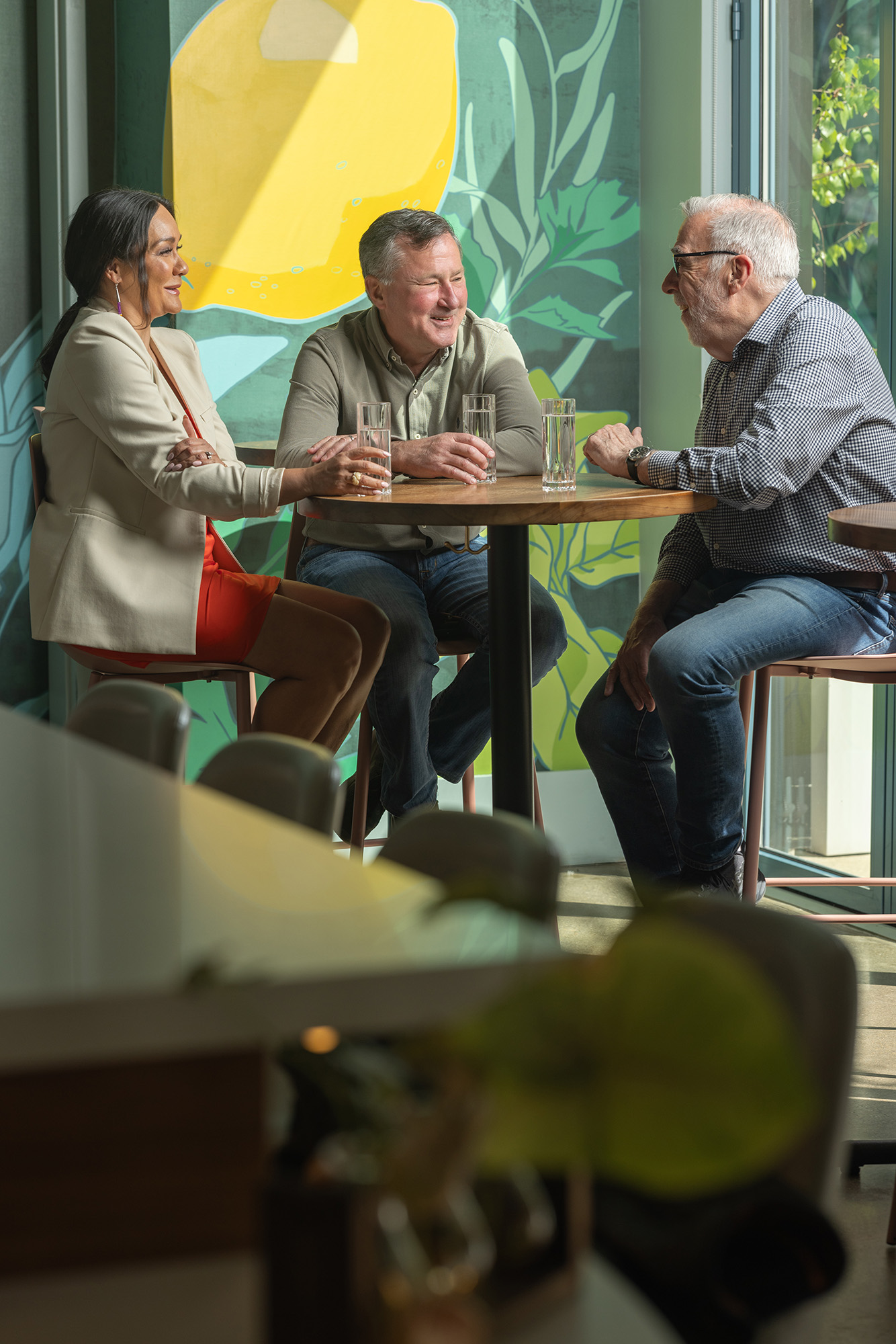
While Brandt battled cancer, construction in the Short North caused the sidewalk in front of Brandt-Roberts Galleries to collapse, and water flooded the basement. The neighborhood was changing, too. Rents were rising. In fact, Brandt’s landlord told her that Lululemon could pay three or four times the rent that she could. When Brandt started looking at other spaces, a colleague suggested she meet with developer Jeff Edwards of Edwards Companies, who approached her with the idea of moving downtown. Relocating a small business is always risky, but the instability in Brandt’s Short North space, not to mention the perfect storm of neighborhood construction, a flooded basement and a life-threatening illness, all pointed to a fresh start in a new neighborhood.
Edwards also communicated a compelling vision for a revitalized downtown Columbus, with many of the initial projects focused on Gay and High. “There’s no thriving metropolitan area in the country that doesn’t have a downtown that is at least holding its own,” says Edwards, who has invested over $100 million downtown, turning eyesores into apartments and condos while bringing in restaurants and galleries.
Lindsay was also in discussion with Edwards about moving his Short North gallery downtown, as was Sherrie Hawk ’82 of Sherrie Gallerie. Over time, a downtown plan involving the trio of galleries began to take shape, and while the pandemic slowed things down, it didn’t change their minds about moving. Meanwhile, the Gay and High neighborhood began to welcome other arts spaces, with No Place Gallery debuting in 2021, followed by Sarah Gormley Gallery a year later.
Then, in September 2022, Brandt got a call from Lindsay’s wife, Lara Lindsay ’00, asking if Brandt could helm Lindsay Gallery’s opening celebration for artist Antoinette Savage’s exhibition the next day. Brandt responded lightheartedly, thinking her friend had a mild illness. “I said, ‘Do you know how messy Duff’s desk is?’”
But Lara wasn’t joking: “He’s in a coma.”
Duff Lindsay grew up in the southern Ohio town of Portsmouth with no connection to art. But when he arrived at Ohio State in 1970, he got interested in film. Initially, he manned the equipment room in the former Department of Photography and Cinema, then worked his way up, eventually shooting Ohio State football games.
In fact, despite his utter lack of football knowledge, Lindsay got lots of footage of beloved Ohio State running back Archie Griffin. “I can remember my boss saying, ‘I know you don’t know anything about the game, but follow Archie Griffin no matter what he does.’ So my camera was all close-ups of Archie Griffin,” Lindsay says. “My boss told me the reason I was good at it was because I didn’t care about the game, so I didn’t get distracted.”
The football games were fun, but it was a chance encounter with an artist that changed the trajectory of Lindsay’s life. A friend needed help on a short film about Elijah Pierce, a self-taught wood carver from Mississippi who opened a barber shop in Columbus and later became an internationally known folk artist. (One of Pierce’s earliest champions was Ohio State grad student and Yugoslavian sculptor Boris Grünwald ’72 MFA, who helped get Pierce his first exhibition at Hopkins Hall Gallery in 1971.)
“Meeting Pierce was eye-opening. Here was this Black barber who didn’t need anybody to tell him he was an artist. It was just part of who he was,” Lindsay says. “I thought the art world was closed to people like me, but then to meet somebody like Pierce, who had this incredible confidence in what he was doing, it really appealed to me. That’s when I got interested in art and started to think about collecting.”
Robert Wagner ’40, ’41 MA, ’53 PhD, who established Ohio State’s Department of Photography and Cinema in the 1960s, helped Lindsay get a job with Channel 10, a locally owned CBS affiliate, where he worked for years as a news photographer and field producer. At the same time, he continued following his interest in folk art, visiting galleries, collecting pieces and learning all he could about the wide-ranging genre often referred to as outsider art—a tag that indicates an artist lacks formal training and operates outside the traditional art world.
In 1999, Lindsay quit his TV job and opened his namesake gallery in Upper Arlington, relocating to High Street in the Short North two years later. He wanted to set himself apart not just by the art on the walls, but by the way he presented the work to others. “I would go to these big galleries in New York and Chicago, and what struck me was, these people know a lot about art, but they don’t know how to talk to people. I could tell they were sizing me up to see if I could afford a $50,000 painting,” Lindsay says. “I wasn’t doing this because I wanted to make a lot of money. I just wanted to do something that I cared about. I loved this art myself, and I think I’m good at talking to people about the art and the artists.”
Lindsay’s approachability and expertise proved to be a powerful combination. Soon he was making a name for himself and his artists at the annual Outsider Art Fair in New York City, the genre’s biggest show in the world. For Lindsay Gallery artist Amber Groome, exhibiting her work at the fair “elevated everything, because here I was being shown alongside masters of outsider art and folk art. It’s been inspiring and encouraging for my personal growth.”
Lindsay was loyal to the Short North neighborhood, so it took some convincing from Edwards when he pitched the move downtown. But Edwards said what Lindsay needed to hear. “Jeff told me, ‘When I die, I don’t want my tombstone to say, ‘He made a lot of money.’ I want it to say, ‘He changed something,’” Lindsay says. “I said, ‘I’m sold.’”
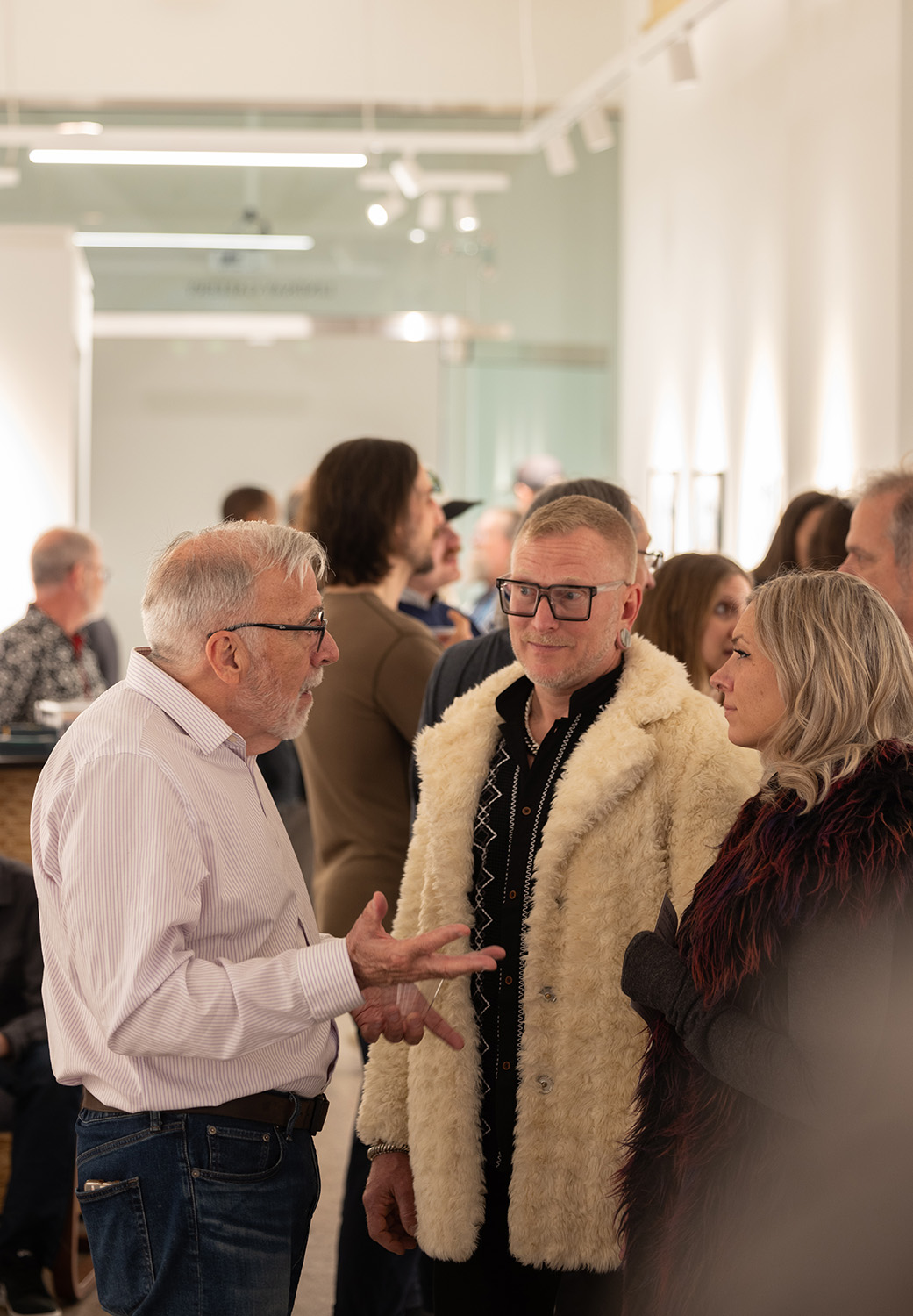
On the morning of Labor Day 2022, the Short North was mostly empty, but Lindsay and Groome were working in the gallery to get ready for Antoinette Savage’s upcoming show. While carrying some shelves down the basement stairs, Lindsay tripped and fell. Groome heard the crash and found him on the basement floor unconscious with his head split open.
Lindsay was taken to the Wexner Medical Center emergency department, where he ended up on a ventilator in a coma. His wife, Lara, didn’t know if he’d make it out alive. And if he did survive such a severe traumatic brain injury, she worried whether he’d be the same person.
Brandt stepped in to handle Savage’s opening, telling people Lindsay was ill, all the while wondering if her friend would survive. Lindsay stayed in the ICU for two weeks, and when he eventually awoke, he couldn’t remember much of anything. “When I visited him, I said something about the new gallery, and he said, ‘What new gallery?’” Brandt says.
Lindsay made encouraging progress at the Wexner Medical Center’s Dodd Rehabilitation Hospital. The rehab process is all a blur to Lindsay, but he remembers a doctor asking him what he intended to do after he recovered. “I said I wanted to get back in my gallery and do what I love,” Lindsay says. “He said, ‘That’s exactly what I want to hear. The people who have something they love and look forward to getting back to, they recover better.’”
It’s still not easy. Lindsay’s short-term memory isn’t what it used to be. He has a hard time with names and dates, and on long days he gets fatigued. But in the new downtown space, Brandt is just a holler away, and he also has new gallery manager Eric Barth ’92, an artist with years of his own gallery experience.
And now Lindsay likes football. “He’s actually gotten even sweeter after the accident,” Lara says.
Margaret Wunderlich worked for Sherrie Gallerie in the Short North for nearly a decade. When Sherrie Hawk decided to retire in 2022 instead of moving downtown, Wunderlich seized the opportunity to open her own gallery, Chaos Contemporary Craft, now between Lindsay and Brandt galleries.
“Part of why it’s so great for me is that I have Duff and Michelle as neighbors,” Wunderlich says. “I’m always learning from them. They both have extreme grit, which you need to survive in this business. And Michelle has been working hard behind the scenes to ensure the success of this Gay and High district.”
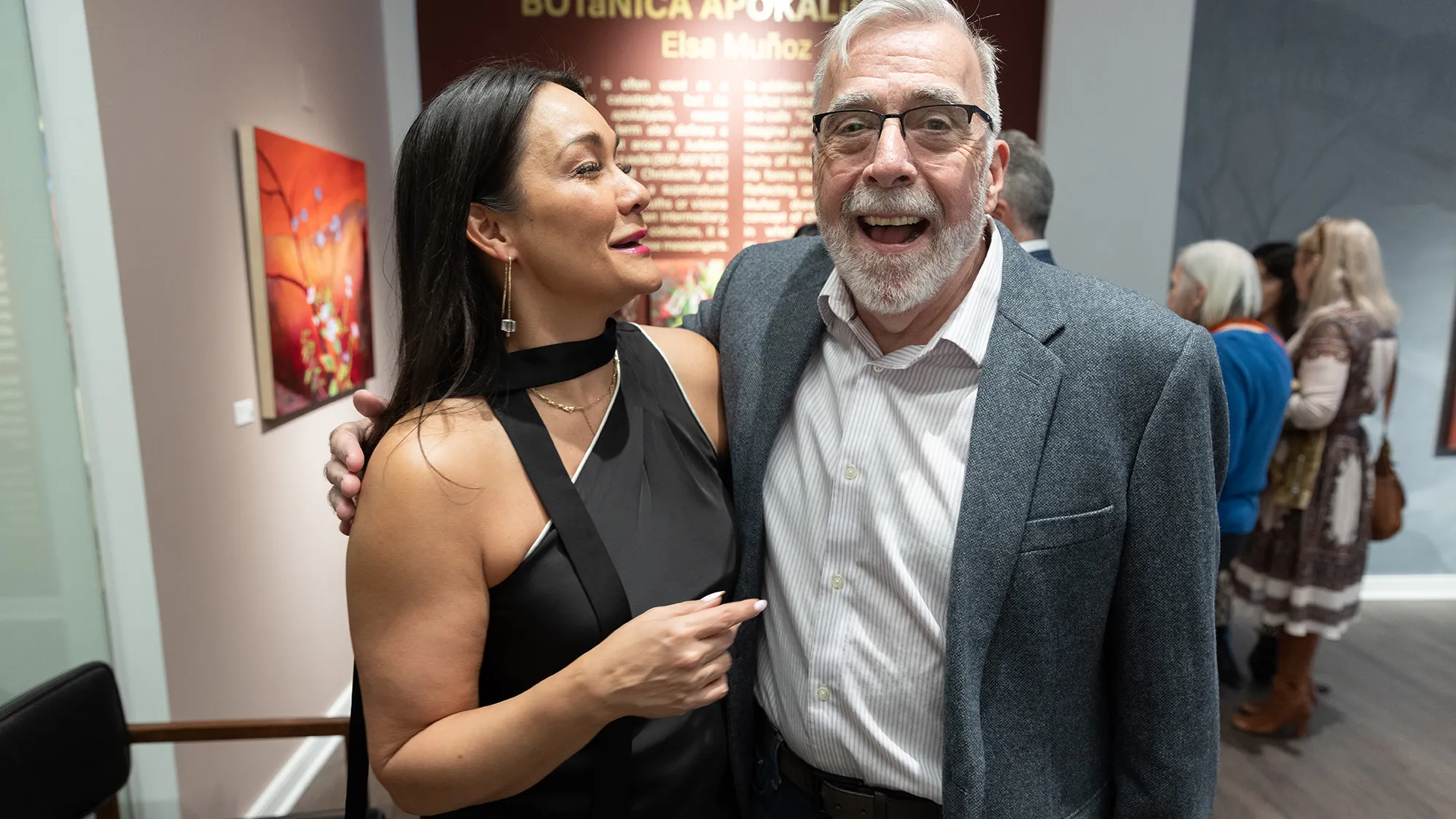
After overcoming health crises, both Brandt and Lindsay are thrilled to spearhead the revival of a key part of downtown Columbus. “Suffering does something to you,” Brandt says. “I’m stronger now.”
“Suffering does something to you,” says Brandt, whose cancer is in remission. “I’m stronger now.” She’s certainly no less ambitious. Brandt is part of Edwards’ downtown advisory board and works as an art consultant. For three years, she was part of the selection committee for the gallery at Ohio State University Comprehensive Cancer Center–The James, and she’s currently working with the Columbus Museum of Art and Ohio State Vice Provost for the Arts Lisa Florman on a public art symposium for fall 2026. Brandt, Lindsay and Wunderlich will also curate a forthcoming sculpture garden outside their galleries.
When Brandt reopened her gallery downtown, she also launched a new venture in the adjacent space: Pecha Projects, an intensely personal endeavor conceived during a trip to her mother’s birthplace in Michoacán, Mexico. As she watched a ceremonial festival of the Purépecha Indigenous people from whom she descends, Brandt was in awe. “When I got back to Columbus, I thought, that’s what I want the project space to be—this intersectionality of arts and culture,” Brandt says. “It’s an opportunity for me to embrace some of the cultural things that I didn’t have an opportunity to when I was a kid.”
The first Pecha Projects installation, Elsa Muñoz’s immersive “Botánica Apokalíptica,” will be on view through mid-July. “We want to take what we’re doing at Pecha and bring it to other cities,” Brandt says.
It would have been easier and understandable if, after all the challenges they faced, Brandt and Lindsay decided to call it quits. Instead, they’re spearheading the revival of a key part of downtown and inspiring the next generation of Columbus gallerists.
“In the last 10 years, there’s been a changing of the guard for galleries in Columbus. Michelle and Duff have seen us through that,” Wunderlich says. “They’re important voices. They’ve been around, and they’re still here.”
